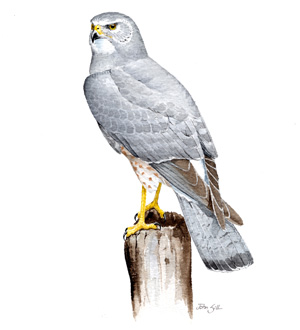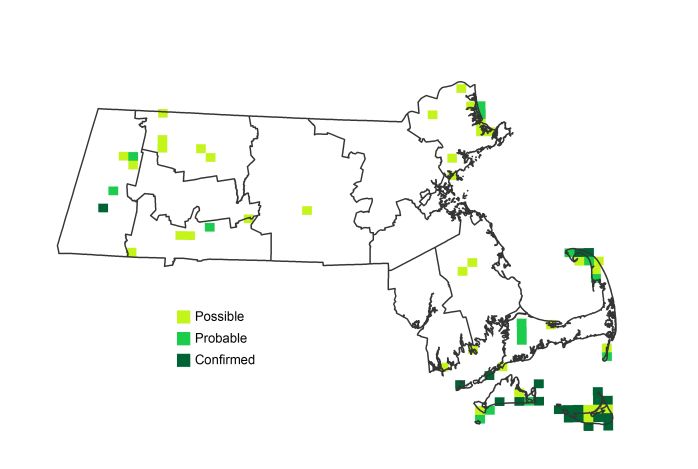Breeding Bird Atlases (BBA)
Find a Bird
Northern Harrier
Circus cyaneus

Local and strongly increasing
Action/monitoring needed
Threatened Species
“Falling hurts least those who fly low.” – Chinese Proverb
When looking for a suitable namesake for their family of vertical/short takeoff and landing jets, the British aviation company Hawker Siddeley merely had to look out over the rolling fields and moors of the English countryside to spot Hen Harriers performing their low-altitude flight aerobatics, and the Harrier Jump Jet was named. Our Northern Harrier, currently thought to be the same species as the English Hen Harrier, shares many of the same aerial acrobatic habits. As the only harrier species breeding in the US, the Northern Harrier is easily recognizable by its habit of gliding swiftly, yet buoyantly just meters above the ground. Although harriers can still be seen in Massachusetts today, they are regular only in areas of open grassland and marsh.
Historic Status
Northern Harriers, historically known as Marsh Hawks or, just to make it more confusing, Hen-Harriers, inhabited Massachusetts in “considerable numbers” in the 1830s (Peabody 1839), making use of the widespread fields, meadows, and wetlands during the state’s greatest agricultural era. At the beginning of the twentieth century, observers still called the species a “common summer resident” (Howe & Allen 1901). By the 1920s, Edward Howe Forbush reported that the birds had definitely declined, and, as the state continued to revert to forest throughout the twentieth century, the breeding population waned in turn.
Atlas 1 Distribution
As the sight of Northern Harriers coursing over agricultural landscapes began to come to an end about the time of Atlas 1, the species had almost entirely retreated to the scrublands and sandplain grasslands of the Cape and Islands. Only a single Possible record in the Lower Worcester Plateau, just over the border from the Connecticut River Valley, hinted at the chance that there might be a few inland holdouts. Although the Outer Cape had a healthy scattering of harrier sightings, the Islands were clearly the place to find harriers in Atlas 1. Nantucket, Tuckernuck, Martha’s Vineyard, and the Elizabeth Islands accounted for nearly all Northern Harrier breeding activity in the state in the 1970s. In fact, no harrier breeding was Confirmed anywhere else in the state during the first Atlas period.
Atlas 2 Distribution and Change
Though hardly widespread in Massachusetts today, Northern Harriers were in a better position at the end of Atlas 2 than at the end of Atlas 1. Despite that fact, inland Confirmations were exceptionally rare. An instance of Confirmed breeding in the Lower Berkshire Hills, along with more than half a dozen occupied blocks west of the Connecticut River Valley, indicated that harriers likely had regained a weak foothold in the western part of the state. The Connecticut River Valley and Lower Worcester Plateau also reflected some harrier activity, but there were no concentrations east of those ecoregions until the extensive marshlands of the eastern Coastal Plains were reached. Harriers were spotted during Safe Dates in small numbers in the Boston Basin and Bristol/Narragansett Lowlands, again speaking to a modest recovery in areas outside the Cape and Islands. Even so, more than half of the Northern Harrier’s Massachusetts distribution was concentrated in that easternmost ecoregion, though the species appeared to lose some ground in the former stronghold of Martha’s Vineyard.
Atlas 1 Map

Atlas 2 Map

Atlas Change Map

Ecoregion Data
Atlas 1 | Atlas 2 | Change | ||||||
Ecoregion | # Blocks | % Blocks | % of Range | # Blocks | % Blocks | % of Range | Change in # Blocks | Change in % Blocks |
Taconic Mountains | 0 | 0.0 | 0.0 | 0 | 0.0 | 0.0 | 0 | 0.0 |
Marble Valleys/Housatonic Valley | 0 | 0.0 | 0.0 | 0 | 0.0 | 0.0 | 0 | 0.0 |
Berkshire Highlands | 0 | 0.0 | 0.0 | 7 | 12.7 | 9.7 | 7 | 13.2 |
Lower Berkshire Hills | 0 | 0.0 | 0.0 | 2 | 6.5 | 2.8 | 2 | 7.4 |
Vermont Piedmont | 0 | 0.0 | 0.0 | 0 | 0.0 | 0.0 | 0 | 0.0 |
Berkshire Transition | 0 | 0.0 | 0.0 | 0 | 0.0 | 0.0 | 0 | 0.0 |
Connecticut River Valley | 0 | 0.0 | 0.0 | 5 | 7.7 | 6.9 | 4 | 8.3 |
Worcester Plateau | 0 | 0.0 | 0.0 | 0 | 0.0 | 0.0 | 0 | 0.0 |
Lower Worcester Plateau | 1 | 1.4 | 2.8 | 2 | 2.5 | 2.8 | 1 | 1.9 |
S. New England Coastal Plains and Hills | 0 | 0.0 | 0.0 | 8 | 2.8 | 11.1 | 6 | 2.7 |
Boston Basin | 0 | 0.0 | 0.0 | 2 | 3.6 | 2.8 | 1 | 1.8 |
Bristol and Narragansett Lowlands | 0 | 0.0 | 0.0 | 4 | 3.5 | 5.6 | 4 | 4.0 |
Cape Cod and Islands | 35 | 25.7 | 97.2 | 42 | 29.2 | 58.3 | 6 | 5.0 |
Statewide Total | 36 | 3.7 | 100.0 | 72 | 6.9 | 100.0 | 31 | 3.7 |
Notes
The Northern Harrier shows a significant decreasing Breeding Bird Survey trend in the eastern US region.



